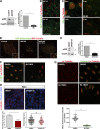JNK regulates ciliogenesis through the interflagellar transport complex and actin networks
- PMID: 37851005
- PMCID: PMC10585068
- DOI: 10.1083/jcb.202303052
JNK regulates ciliogenesis through the interflagellar transport complex and actin networks
Abstract
The c-Jun N-terminal kinase (JNK) regulates various important physiological processes. Although the JNK pathway has been under intense investigation for over 20 yr, its complexity is still perplexing, with multiple protein partners underlying the diversity of its activity. We show that JNK is associated with the basal bodies in both primary and motile cilia. Loss of JNK disrupts basal body migration and docking and leads to severe ciliogenesis defects. JNK's involvement in ciliogenesis stems from a dual role in the regulation of the actin networks of multiciliated cells (MCCs) and the establishment of the intraflagellar transport-B core complex. JNK signaling is also critical for the maintenance of the actin networks and ciliary function in mature MCCs. JNK is implicated in the development of diabetes, neurodegeneration, and liver disease, all of which have been linked to ciliary dysfunction. Our work uncovers a novel role of JNK in ciliogenesis and ciliary function that could have important implications for JNK's role in the disease.
© 2023 Chatzifrangkeskou et al.
Conflict of interest statement
Disclosures: The authors declare no competing interests exist.
Figures










Similar articles
-
The apical ciliary adhesion complex is established at the basal foot of motile cilia and depends on the microtubule network.Sci Rep. 2022 Nov 8;12(1):19028. doi: 10.1038/s41598-022-22871-0. Sci Rep. 2022. PMID: 36347932 Free PMC article.
-
Roles of the actin cytoskeleton in ciliogenesis.J Cell Sci. 2022 May 15;135(10):jcs259030. doi: 10.1242/jcs.259030. Epub 2022 May 16. J Cell Sci. 2022. PMID: 35575063 Free PMC article. Review.
-
Proliferation associated 2G4 is required for the ciliation of vertebrate motile cilia.Commun Biol. 2024 Nov 4;7(1):1430. doi: 10.1038/s42003-024-07150-0. Commun Biol. 2024. PMID: 39496919 Free PMC article.
-
Addressing the Functional Determinants of FAK during Ciliogenesis in Multiciliated Cells.J Biol Chem. 2017 Jan 13;292(2):488-504. doi: 10.1074/jbc.M116.767111. Epub 2016 Nov 28. J Biol Chem. 2017. PMID: 27895123 Free PMC article.
-
The entangled relationship between cilia and actin.Int J Biochem Cell Biol. 2020 Dec;129:105877. doi: 10.1016/j.biocel.2020.105877. Epub 2020 Nov 7. Int J Biochem Cell Biol. 2020. PMID: 33166678 Review.
Cited by
-
Plakophilin 3 Is Involved in Basal Body Docking in Multiciliated Cells.Int J Mol Sci. 2025 Jun 4;26(11):5381. doi: 10.3390/ijms26115381. Int J Mol Sci. 2025. PMID: 40508190 Free PMC article.
-
Actin cytoskeletal regulation of ciliogenesis in development and disease.Dev Dyn. 2024 Dec;253(12):1076-1093. doi: 10.1002/dvdy.724. Epub 2024 Jul 3. Dev Dyn. 2024. PMID: 38958410 Review.
-
Reversible Modulation of Motile Cilia by a Benzo[e][1,2,4]triazinone: A Potential Non-Hormonal Approach to Male Contraception.Cells. 2025 May 9;14(10):688. doi: 10.3390/cells14100688. Cells. 2025. PMID: 40422191 Free PMC article.
-
Structure-Activity Analysis Reveals Perturbed Cilia-Jun N-Terminal Kinase Signaling in MAPKBP1-Associated Kidney Disease.Kidney Int Rep. 2025 Jun 4;10(8):2836-2851. doi: 10.1016/j.ekir.2025.05.049. eCollection 2025 Aug. Kidney Int Rep. 2025. PMID: 40814602 Free PMC article.
-
TNF-alpha promotes cilia elongation via mixed lineage kinases signaling in mouse fibroblasts and human RPE-1 cells.Cytoskeleton (Hoboken). 2024 Nov;81(11):639-647. doi: 10.1002/cm.21873. Epub 2024 May 20. Cytoskeleton (Hoboken). 2024. PMID: 38767050
References
-
- Björkblom, B., Padzik A., Mohammad H., Westerlund N., Komulainen E., Hollos P., Parviainen L., Papageorgiou A.C., Iljin K., Kallioniemi O., et al. . 2012. c-Jun N-terminal kinase phosphorylation of MARCKSL1 determines actin stability and migration in neurons and in cancer cells. Mol. Cell. Biol. 32:3513–3526. 10.1128/MCB.00713-12 - DOI - PMC - PubMed
Publication types
MeSH terms
Substances
LinkOut - more resources
Full Text Sources
Research Materials
Miscellaneous

